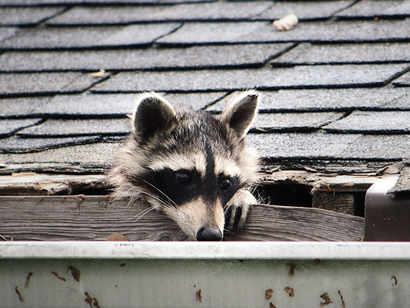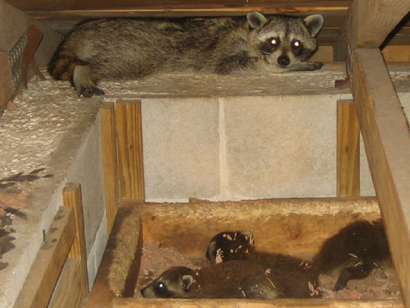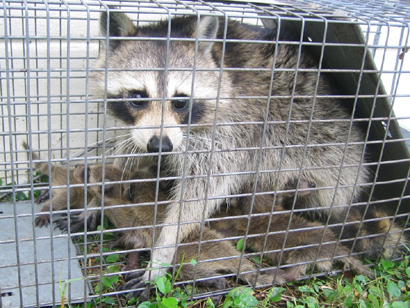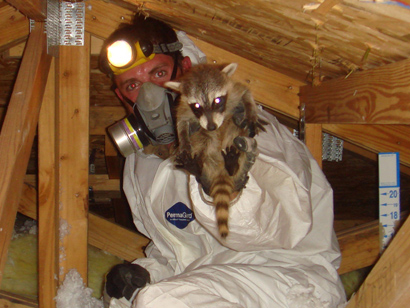- Raccoon Removal - Information about the humane trapping and removal of raccoons.
Raccoon Removal
Raccoons are strong, agile, adaptable, and they are very common in urban areas. They commonly break into garbage cans, dumpsters, steal pet food, or even enter homes via pet doors. They are great climbers, and they commonly enter attics of homes. They will rip open a hole and set up a denning area, and raise a litter of babies. They can cause a great deal of damage, and spread diseases with their feces, so removal is usually recommended.
COMMON PROBLEMS: Raccoons are now much more common in cities than in the forest. They have learned to adapt to urban environments, use human shelter and food sources, and they have largely lost fear of people. They are agile, strong, intelligent, and have nimble hands. Thus, they cause some of the following problems:
- Breaking into an attic, and setting up a nest
- Crawling into a chimney and living there
- Eating from garbage cans, pet food, bird seed, etc.
- Killing and eating pet birds, decorative fish, chickens, etc.
- Depositing feces in swimming pool, on porch, yard, etc.
- Digging up your yard, eating crops, etc.
- Concern over fearless raccoon, or attack on pets.
- Concern about a sick or rabid raccoon on property.
RACCOONS IN THE ATTIC: This is a very complex case. This almost always involves an adult female and a litter of baby raccoons. The nest of baby raccoons must be found & removed, and the mother trapped. Here are the general steps for removing raccoons from an attic.
- Step 1: Inspect the home, and find the entry hole(s), which are very large and obvious.
- Step 2: Enter the attic. This is crucial. You might see the adult female.
- Step 3: Search the attic carefully, and find and remove the litter of baby raccoons by hand, and place in sack. Beware of attacking female.
- Step 4: Use a trap divider and place the live babies as "bait" to lure the female into the cage trap. This is difficult, and must be done just right.
- Step 5: Relocate the whole family together, at least 10 miles from capture site.
- Step 6: Repair the entry holes with pro-grade repairs, and fix other damage in the attic.
- Step 7: Clean the attic, removing all feces, and spray with enzyme cleaner.
GENERAL RACCOON TRAPPING: Raccoon trapping is subject to state laws regarding capture and relocation or euthanization of wildlife. If you have unwanted raccoons outside the home, in some cases, the only fix is to trap and remove the nuisance wildlife. We can safely, legally, and effectively catch and remove your nuisance raccoons. Trapping is an art, and most amateur attempts go awry for a variety of reasons. An intimate knowledge of raccoon behavior, both prior to and after trapping, and of various raccoon trap types is necessary to ensure that the raccoon is trapped and removed without incident.
- STEP 1: Determine if trapping is necessary, or if there is a preventative alternative.
- STEP 2: Select the right trap for the situation, of at least a dozen types of raccoon traps.
- STEP 3: Set the traps in the correct areas, in the shade, camouflaged, on a flat sturdy surface, away from any obstructions or areas that can be damaged, etc.
- STEP 4: Use the correct bait. Don't use meat-based baits, which can attract stray cats.
- STEP 5: Monitor the trap daily, remove trapped animals (carefully!) and transport them.
ATTIC DECONTAMINATION & OTHER SERVICES: In some situations, it may be desirable to clean your attic after you've removed raccoons from the space. They can leave behind large amounts of droppings, urine, hair, oils, food, nesting material, and so on. These remnants can attract insects like cockroaches, and the scent left behind can encourage new raccoons to attempt to chew or break their way into your house. It's possible or likely that mold will grow on the areas of feces and urine, which damages wood or sheetrock. Some of the mold can potentially cause diseases that people can catch, and some of the feces themselves can cause diseases, such as Salmonella or Leptospirosis, and raccoon feces can contain roundworm eggs, which can infect people. It's also adviseable to repair any torn ductwork in an attic, along with torn pipe insulation or chewed electrical wires.
- We remove or vacuum all droppings, or remove all the soiled insulation.
- We fog the attic with a special enzyme-based cleaner that destroys any organic matter and deodorizes the space.
- We repair damage, such as ductwork, electrical wires, pipes, insulation, and more.
Sometimes the best place to start is learning about the animal itself. Learn About Raccoons - their natural diet, if raccoons live or travel in packs, whether they live in urban areas, or wild areas, average sizeand mating habits. It's important to know the symptoms of a sick raccoon, as well as what to do if you encounter a sick raccoon - as well as what kind of diseases you can get from Raccoons. We can also give advice on What attracts raccoons and generally How to keep raccoons away from your property. Learn how to identify Raccoon Feces, and learn about whether or not raccoon feces are dangerous to touch or breathe. One of the questions we get most is: Do all raccoons have rabies? Learn, too, if a raccoon that is active during the daytime rabid.
We often get asked about Baby Raccoon, as well as if you should feed a found baby raccoon, and What should I do if I find an orphaned baby raccoon wandering about?.
Raccoons can find a means to get into trouble just about anywhere. We have advice about not only about Raccoon Prevention , but what to do to keep thece nuisance animals out of just about anywhere, including:
Raccoon in the Attic - Info about what to do if you have raccoon in the attic.
Raccoon on the Roof - If you hear scratching on the roof, and think it's a raccoon.
Raccoon in the Chimney - Information about removing raccoon in a chimney.
Raccoon in Chicken Coop - Information about how to keep raccoons out of a chicken coop.
Raccoon in the Walls - What to do if you hear raccoon in the walls, scratching.
Raccoon in Bird Feeder - How to keep raccoons out of my bird feeder
Raccoon in Garden - How to keep raccoons out of your garden
Raccoon under Porch - What to do about a raccoon under the porch
Raccoon and Garbage Cans - How to keep raccoons out of your garbage cans
Raccoon and Pools - How to prevent raccoons from pooping in your swimming pool
Raccoon in Dumpster - How do you remove a raccoon stuck in a dumpster?
The best way to Get Rid of Raccoon is to prevent it from entering/damanging your property to begin with. And, believe me, raccoons can cause a lot of damage. Though you can check to see if Homeowners Insurance Pay for Raccoon Damage, as well as if The City Or County Animal Services Will Help Me With A Raccoon Issue?If you had a raccoon in your attic, you'll need to know how to clean raccoon feces out of an attic. Learn more, too, about what diseases raccoons carry.
We did an analysis of Raccoon Repellents for your property, your attic, as well as for your chimney. We also can offer advice about using mothballs or ammonia to help repel raccoons, and can answer the question: What is raccoon eviction fluid?. We can also offer advice about how you can know if there are Baby Raccoons in the Attic, and what to do if you do indeed have a nest of raccoons in the attic.
If the critter has already made it into your house there are few options about how to remove it. First, you may want to consider Is it legal for me to trap a raccoon?. Learn about How To Trap a Raccoon, as well as What Bait Catches Raccoon, and What equipment is needed to trap a raccoon? After you have successfully captured the animal, you need to think about what to do afterwards - including where to relocate the animal. You may also want to read: Is it safe to handle a raccoon with bare hands?. If the raccoon is just too smart for your cage, we have advice: What to do about a cage-shy (hard to trap) raccoon? Ultimately, you need to consider: Should I hire a pro, or remove raccoons myself? and Will A Pest Control Company Remove A Raccoon? I often get asked How to Kill a Raccoon, and What are some humane ways to kill a raccoon? whether in the home or in the yard. There are some pretty important questions about how, when, and why to kill a raccoon. Of course, the next question we get asked is about How to Find and Remove a Dead Raccoon. These intelligent but pesky creatures can bring a lot of damage to your property - you'll want to move quickly to remove any raccoon from your House, your chimney, out from under your shed or porch, and even out of a wall. Learn how to get raccoons out of your attic and off of your Roof, and how to catch one with a snare pole. Learn what Bait is best for catching raccoons, and even if they make good pets.
Read more about how to Keeping Raccoons Away from your property altogether - but especially to keep them out of your house and attic. Find out if raccoons attack people, and the first steps you should take if a raccoons got inside your house. Learn if you should ever poison a raccoon and if they do in fact use tools. Read about raccoon roundworm, what wildlife rehabilitators do with raccoons, if a raccoon in the attic will have a nest of babies, and how to get raccoons out of your attic.
Raccoon Biology and Information
The North American Raccoon or Procyon lotor in scientific terms is an abundant mammal the size of an extra-large house cat that is prevalent in many different habitats across the North American continent.
Biology - This mammal is an omnivore, which means it eats a wide variety of food. Mainly a raccoon’s diet consists of bugs, plants and fish when on its own. Close to cities it scavenges rubbish bins for all sorts of food scraps that people toss. It has very agile front paws that it can use in much the same manner a person uses their hands. Its physical distinctions are its ambling gate, hunched back and dark facial mask. The raccoon has often been hunted for its, soft thick fur for apparel and its tail used for decorative features.
Life Cycle And Reproduction - For the longest times it was thought that these mammals were very much a solitary animal. Many studies that were done in the nineties have shown they live in groups according to gender. These nocturnal creatures tend to breed when there is an increase in daylight hours. Generally from the end of January to some time in middle March is when they start to mate. Although this time period can fluctuate and it doesn’t always seem to relate to solar cycles. Also, if the female raccoon doesn’t get pregnant or aborts the pregnancy she can become fertile between 80 and 140 days later. They are pregnant for around 63 days after which they usually deliver between 2 and 5 babies, which are also called kits. The size of the litter does vary geographically and some studies have shown larger litters are born where their mortality rates are higher-nature at its best! The babies are deaf and blind when they are born but this only lasts about 21 days. Mother’s tend to nurse their young until they are about 16 weeks old. After which the kits have been introduced to the social group the mother tends to feed with (usually other female raccoons from her family tree) and they start to live on their own. In captivity they have been known to live close to 20 years though the wild members of this species generally average closer to five years.
Habitat - Generally speaking the raccoon enjoys living in forests and they often choose the hollows of trees or crevices in rocks to make a den. Most often they like to select an area that is near a marsh or river so there’s a steady food and water source. Since raccoons love small fish and crustaceans found in swampy watering holes this makes these environments their ideal living quarters. When living in more urban areas they may choose an outbuilding or even an attic to get out of the elements and raise their young.
Common Diseases These Animals Can Spread - One of the most well-known diseases a raccoon can carry is rabies. Often it’s important that a person steers clear from a raccoon that is out in the day time or appears to not be afraid of humans. These are signs the animal may be sick and this could mean rabies, which of course is transmittable to humans and distemper which dogs can get. They are known to be riddled with many forms of parasites including roundworms. These are easily passed to a person’s pets. In addition, their habit of playing in creek beds makes them carry salmonella bacteria.
Common Nuisance Complaints - These are some of the most adaptable mammals on the North American continent. Because they enjoy a wide variety of food scraps that people toss in their rubbish, living close to humans can be the ideal situation for them. Common complaints are that they have set up a home in the attic or garage and occasionally a dog house. A mother can become very aggressive when defending her young. They do carry diseases that can be passed on to pets and people alike. Their scat or droppings carry high amounts of bacteria that can cause health problems when it dries and spores go airborne. They can be very destructive with rubbish bins, outside pets and their agile hands help them to get into otherwise secure food stuffs.





